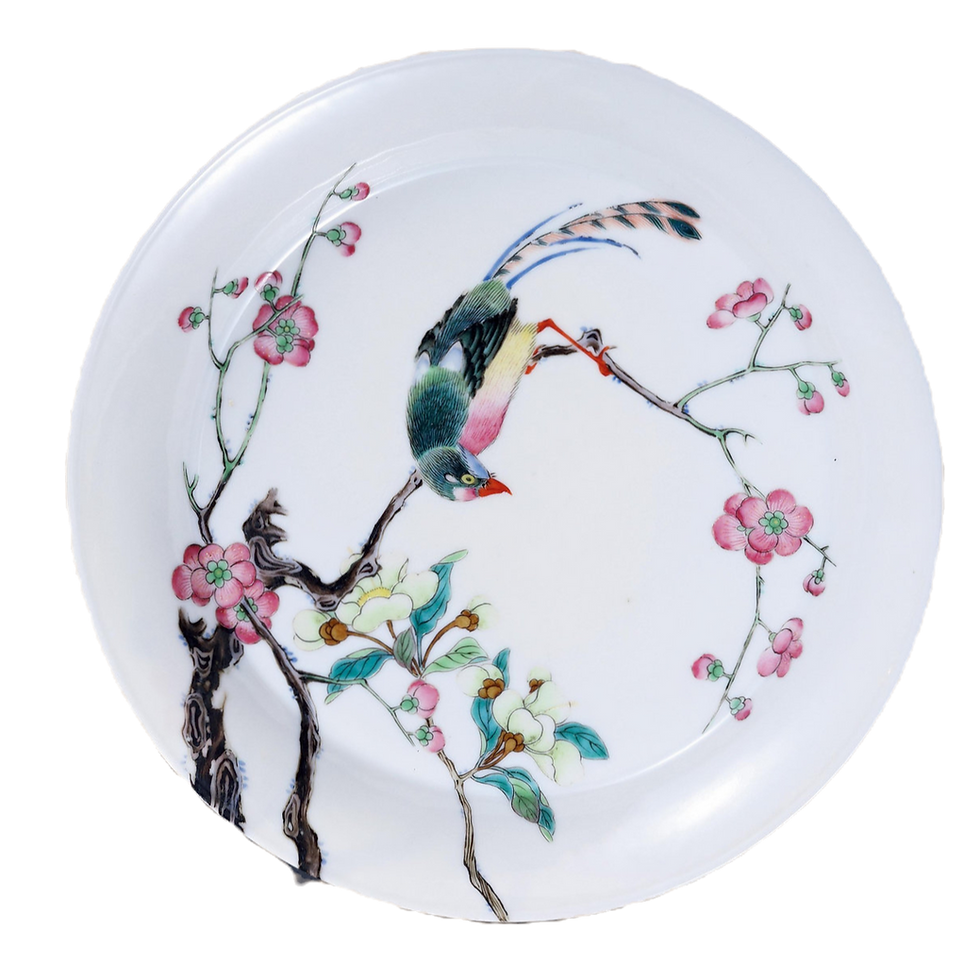Beyond the legend of Dayazhai porcelain: Between myth and authenticity
- Philippe Smolarski
- Apr 8
- 6 min read
Last Friday, Moon Rabbit Art received an email from a person who wanted an in-house appraisal for some imperial porcelain from the late Qing dynasty. The email included a mobile phone number. I called Sebastien, a businessman who had lived in Hong Kong, Tokyo, and Taipei for thirty years, and we scheduled an appointment for this Monday.
In fact, he lives very near my office, just a few hundred meters from Parc Monceau, on the top floor of a building with a wonderful view of the garden and the city. He welcomed me and led me into his office where his treasures were kept and exhibited in state-of-the-art display cases—a miniature private museum.
His collection consists of about 100 pieces collected over a period of 30 years, all bearing the Dayazhai mark. He told me they once belonged to the Empress Dowager Cixi... hmm, almost... let me explain.
The Magnificent Dayazhai Collection
Sebastien's collection was breathtaking in its scope and variety. From delicate cups no larger than an egg to magnificent vases standing nearly a meter tall, each piece displayed the characteristic Dayazhai motifs that have captivated collectors for generations. The assembly represented countless hours of hunting through auction houses and private sales across Asia.
Most impressive was his comprehensive representation of the seasonal designs—the essence of the Dayazhai style . As we moved through the collection, Sebastien had organized the pieces by their seasonal themes, allowing us to appreciate the subtle symbolic language of imperial Chinese porcelain.
Understanding Dayazhai: The Hall of Great Refinement
"What exactly is Dayazhai?" I asked, though I knew the answer well.
Sebastien's eyes lit up. "Dayazhai means 'Hall of Great Refinement.' It was the private studio of Empress Dowager Cixi within the Summer Palace," he explained with enthusiasm. "After the old Summer Palace was destroyed by foreign troops, she commissioned thousands of porcelain pieces for her new quarters. These were to be the finest expressions of Chinese porcelain art—fit for an empress who effectively ruled China."
He was correct, though the historical reality is more nuanced than collectors often acknowledge. When Cixi directed the reconstruction of the imperial residence in the 1880s, she commissioned porcelain works of exceptional quality. Approximately 5,000 pieces were ordered from the imperial kilns at Jingdezhen, each intended to reflect her personal aesthetic sensibilities and to furnish her newly constructed pavilions at the Summer Palace.
The Distinctive Seasonal Patterns
"These patterns aren't just decorative," Sebastien explained as we examined each seasonal grouping. "They reflect the Chinese philosophical understanding of time and nature."
Indeed, the Dayazhai designs represent one of the most sophisticated expressions of seasonal symbolism in Chinese art. Let me walk you through the distinct characteristics of each seasonal pattern as represented in Sebastien's collection:
Spring - The Two Distinct Patterns
Sebastien proudly displayed a pair of exceptional bowls representing the two primary Spring designs.
"The first Spring pattern is my personal favorite," he said, indicating a bowl with a luminous turquoise ground. Against this vibrant backdrop, delicately painted roses and wisteria branches curled gracefully, rendered in the famille rose palette. A small Hwamie bird perched among the branches, its feathers meticulously detailed in shades of brown and white.
"The artistry here is extraordinary," I noted, examining the brushwork. "The way the pink roses seem to float above the surface creates a remarkable depth."
This first Spring pattern is indeed among the most coveted Dayazhai designs. Its symbolic resonance is profound—the wisteria represents longevity and poetic sentiment, while the roses symbolize youth and beauty. The Hwamie bird, often associated with spring's arrival, completes this representation of nature's rebirth.
Nearby sat examples of the second Spring pattern—equally beautiful but with a completely different mood. These pieces featured a sunshine yellow ground, upon which opaque white peonies bloomed in full flower. Moths fluttered among the blooms, and leaves were rendered in sophisticated grisaille technique.
"The contrast between the two Spring designs is fascinating," I observed. "One celebrates the vibrancy of early spring with its turquoise background, while this yellow ground pattern captures the golden light of late spring."
Sebastian nodded enthusiastically. "And notice the peony—the 'king of flowers' and symbol of wealth and honor. Perfect for an empress, wouldn't you say?"
Summer - Lotus and Herons
Moving to the Summer section, Sebastien displayed several pieces with pristine white grounds. Upon this canvas-like surface, naturally rendered lotus flowers and leaves created a serene aquatic scene. Elegant herons waded among the lotuses, some standing alert, others with necks gracefully bent.
"The Summer pattern feels so refreshing," I remarked. "The white ground creates a sense of light and air."
"Exactly!" Sebastien agreed. "And the lotus has profound meaning in Chinese culture—rising clean from the mud to bloom, it represents purity and enlightenment."
The technical execution of these Summer pieces demonstrated remarkable skill, particularly in the subtle green gradations of the lotus leaves and the dimensional quality of the flowers. The herons—symbols of longevity and patient wisdom—were painted with fluid brushstrokes that captured their elegant forms in motion.
Autumn - Chrysanthemums and Hibiscus
The Autumn section presented pieces with another turquoise ground, but here the mood shifted dramatically. Opaque white chrysanthemums and hibiscus flowers stood out against the vibrant background, while leaves and foliage were rendered in sophisticated grisaille technique. A single blackish bird in flight added dynamism to the composition.
"The chrysanthemum is the flower of autumn par excellence," I explained. "In Chinese tradition, it represents resilience—blooming when other flowers fade. It was especially significant for the imperial household."
Sebastien pointed out the subtle details—the precise center of each chrysanthemum rendered with tiny brushstrokes, the graceful curve of the hibiscus petals, and the way the grisaille technique created a sense of fading that perfectly captured autumn's melancholy beauty.
Winter - The Purple Ground Treasures
"And now for the rarest of all—the Winter pattern," Sebastien announced with particular pride as we approached a display cabinet containing several purple-ground pieces.
These Winter pieces were truly spectacular. Against a rich purple ground—itself a technical achievement in porcelain production—bloomed vibrant poppies in shades of purple, pink, and yellow. Buds and possibly peach flowers (or perhaps single miniature roses) complemented the composition. The foliage was rendered in subtle grey-green enamels, and a striking black and white bird in flight animated the scene.
"The purple ground is particularly difficult to achieve in porcelain," I noted. "The manganese pigment is notoriously unstable in the kiln."
"Which is why these Winter pieces are the most coveted," Sebastien confirmed. "Even among modern replicas, the purple ground pieces command the highest prices."
The symbolic resonance of these Winter pieces is profound—winter's dormancy contains the promise of renewal, just as the poppies and plum blossoms signal life's persistence even in hardship. For the Empress Dowager, who weathered numerous political storms throughout her reign, this symbolism would have held particular significance.
The Assessment
After thoroughly examining several key pieces with a loupe and portable UV light, I had to deliver my assessment.
"Sebastian, you have an extraordinary collection of Dayazhai-style porcelain—truly museum quality in terms of craftsmanship. The painting work on several pieces is exceptional."
His face brightened, but I continued carefully.
"However, I don't believe these pieces were ever in the Empress Dowager's possession. Most appear to be excellent examples from the Republican period—roughly 1920s to 1940s—when some of China's finest porcelain artists were recreating imperial styles."
His expression fell slightly. "So they're just copies?"
"I wouldn't say 'just' copies," I replied. "They're important artistic works in their own right—made by master craftspeople working in a tradition that spans centuries. Some of your pieces may even have been made by the same hands that once created pieces for the imperial court, just a generation later."
Sebastian considered this. "But they're not authentic Dayazhai pieces?"
"Authentication is complicated with Chinese porcelain," I explained. "These are authentic porcelains from the Chinese ceramic tradition, made in the Dayazhai style. But they weren't made for the imperial household during Cixi's lifetime."
Sebastian looked around his collection silently for a moment before a smile crossed his face.
"Well," he said, picking up a particularly beautiful turquoise bowl, "I suppose this means I can actually use one for my morning coffee without committing historical sacrilege?"
I laughed. "Exactly. And you know what? The craftsmanship might be just as good as what the empress herself used."
With the appraisal complete, I had to rush back to my office where two more clients were waiting for consultations. The day passed in a blur of authentication certificates and valuation forms, but my mind kept returning to those vibrant Dayazhai pieces and their fascinating history.
That evening, Sebastien and I met again, this time at a lively brasserie near Parc Monceau. No precious porcelain graced our table—just hearty French food and excellent wine. As we clinked glasses, he seemed at peace with the morning's revelations.
"You know," he said between bites of his perfectly cooked steak, "I've been thinking. Perhaps it's better this way. Living with 'almost imperial' treasures means I can actually enjoy them without the constant anxiety."
"The best collections reflect the collector's passion, not just historical provenance," I replied.
Sebastien raised his glass in a toast. "To the joy of collecting, then—with or without the empress's approval!"
As our evening wound down amid the warm buzz of the brasserie, I reflected that in my years of appraising, the most valuable assets often weren't the objects themselves, but the stories they carried and the passions they inspired. Sebastien's "almost imperial" collection might not have been touched by Cixi's hands, but it had certainly captured something of her spirit—a celebration of beauty, craftsmanship, and the passing seasons that continues to speak to us more than a century later.




Comments